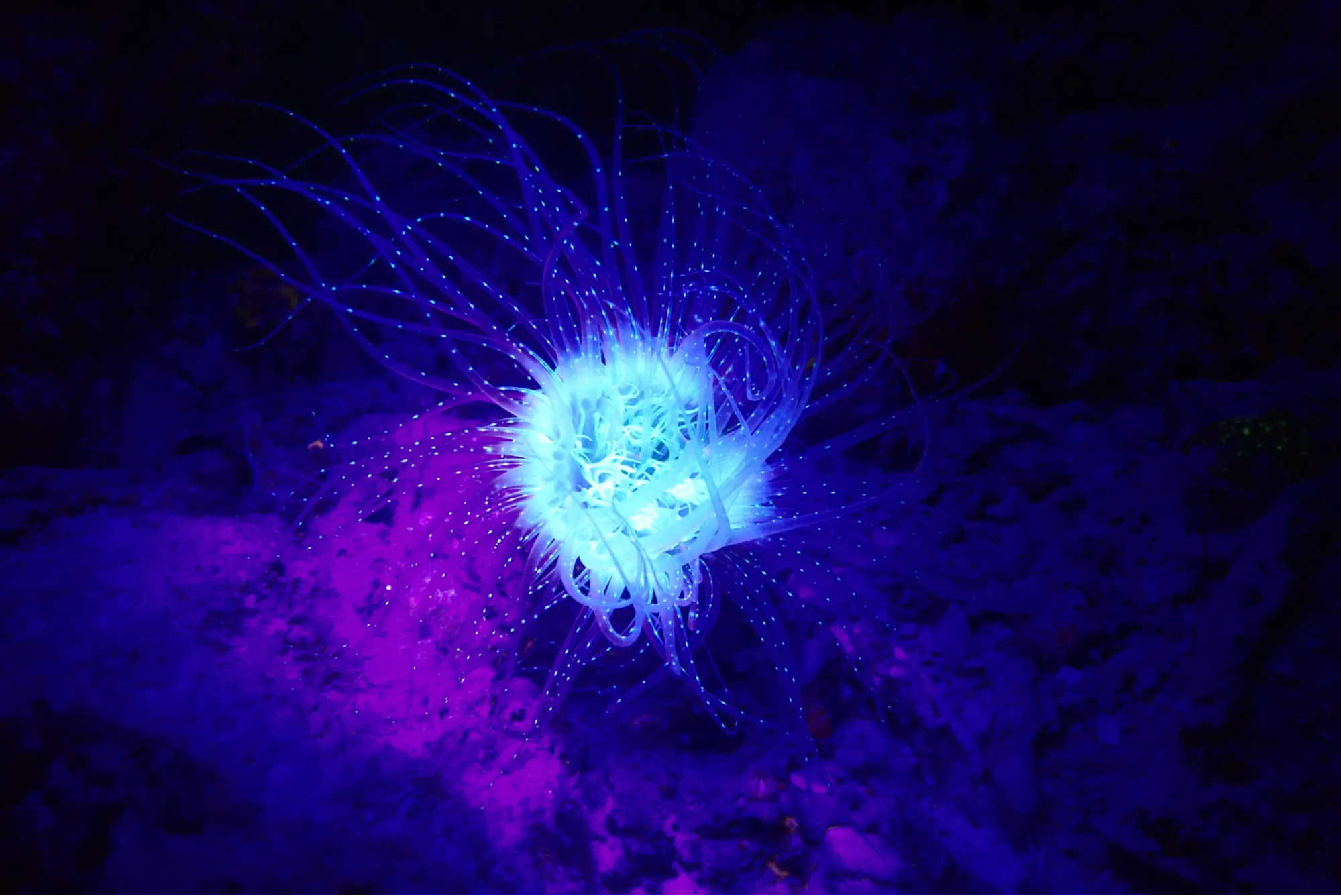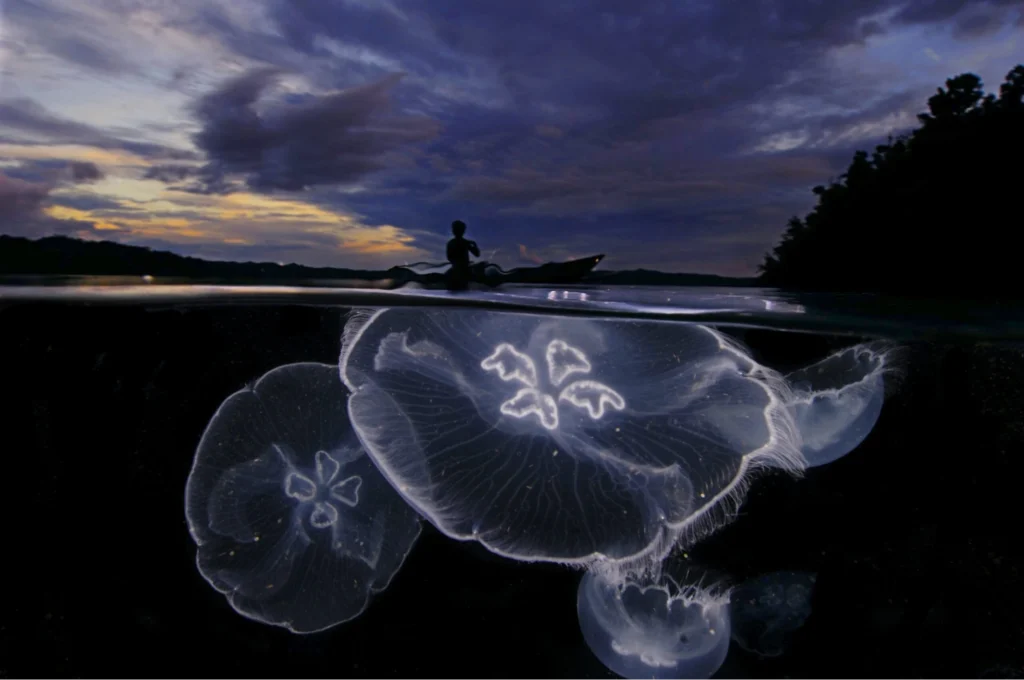
Discover the Glow: Fluorescence Diving in Raja Ampat
- April 15, 2025

Fluorescence diving reveals a hidden, neon world beneath the surface. In Raja Ampat, this surreal experience comes alive under the stars.
Bioluminescent diving—also known as fluoro diving—is an extraordinary type of night diving that uses blue or ultraviolet lights to reveal the glowing, biofluorescent qualities of certain marine species.
Under a special UV light and yellow mask filter, corals, anemones, and fish like scorpionfish or lizardfish can emit otherworldly greens, pinks, and oranges. The effect is dreamlike: as though someone painted the reef with neon.
This isn’t the same as night diving. Fluorescence diving offers a more intense, surreal visual field where common reef dwellers suddenly transform into electric artwork. At Papua Diving Resorts, it’s not just an excursion—it’s a revelation.
Raja Ampat’s unparalleled biodiversity and pristine coral ecosystems make it one of the best places in the world for fluorescence diving.
With over 500 species of coral and thousands of fish, the conditions are ideal for spotting a variety of biofluorescent marine life. Night visibility here is excellent due to the low light pollution and healthy reef systems.
Soft corals, brain corals, and certain crustaceans tend to respond most vividly to UV light. Diving here means you’re not only surrounded by rare species but also by ideal conditions that enhance the glowing spectacle.
Because Raja Ampat's waters are so clear and untouched, light penetrates cleanly and doesn't scatter—which allows for brilliant color displays.
Read more: Raja Ampat for Solo Diving Holidays
A fluorescence dive with Papua Diving Resorts begins long before you hit the water. The team provides a full briefing on fluoro diving, covering the science, safety, and gear involved. Then, as twilight fades, you gear up and head into the water equipped with UV/blue dive lights and yellow mask filters.
The moment you descend, everything changes. The familiar reefscape becomes unrecognizable as glowing anemones wave in neon, and unsuspecting critters pulse with vibrant color. These guided dives are designed to maximize your viewing experience while ensuring safety and reef respect.
Dives typically take place after sunset, when conditions are calmest and the underwater world is most active. Peak fluorescence visibility usually occurs during the dry season (October to April), when visibility is at its best and plankton levels are low.
Read more: Diving Safety in Raja Ampat with Top Quality Equipment
Fluorescence diving requires some specialized equipment:
At Papua Diving Resorts, all required gear can be rented or provided as part of a guided experience. Whether you’re staying at Sorido Bay Resort or Kri Eco Resort, the dive team will ensure your equipment is properly calibrated and suited to your skill level.
Fluorescence diving offers incredible opportunities for underwater photography—but it comes with challenges. Low light conditions, long exposure times, and fast-moving subjects can make it a difficult but rewarding endeavor.
The Raja Ampat SEACAM Center at Papua Diving Resorts offers access to professional-grade camera gear, tailored for low-light and fluorescence photography. Expert staff are available to advise on settings, compositions, and techniques.
Some tips for capturing the perfect shot:
The best time for fluorescence diving in Raja Ampat is during the dry season, from October through April. During these months, the sea is calmer, and visibility is typically at its peak. New moon nights offer the darkest conditions—ideal for the highest contrast fluorescence.
Unlike traditional night diving, which may prioritize fish behavior or predator activity, fluoro dives are all about optics. Light, contrast, and water clarity are everything—and Raja Ampat delivers.

The difference between a day dive and a night dive lies in the sensory experience. During the day, light reveals the reef in all its sunlit color, while at night, it becomes a realm of shadow and mystery.
Add fluorescence diving, and it transforms yet again—into a living gallery of glowing creatures, hidden colors, and secrets only visible under UV light.
Whereas a day dive might introduce you to the biodiversity of Raja Ampat, a fluorescence dive unveils a parallel world—one rarely seen and never forgotten.

Raja Ampat is one of the only places in the world where divers can experience fluorescence diving in such pristine, vibrant conditions. With expert guides, top-tier equipment, and access to the SEACAM Center and workshops, Papua Diving Resorts offers the ultimate introduction to this surreal form of exploration.
Ready to discover a world that glows in the dark? Book your stay at Sorido Bay Resort or Kri Eco Resort and experience the magic of fluorescence diving in Raja Ampat.
Conservation begins with wonder—and it glows brightest beneath the surface.

